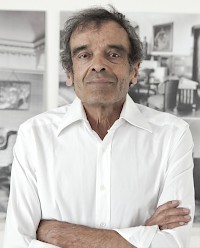Vita
Harun Farocki, undoubtedly one of the world's most relevant and renowned filmmakers in the field of experimental documentary, has written, realised and produced a total of over 90 films whose influences reverberate into the most varied disciplines. Born 1944, he commenced his studies at Deutsche Film- und Fernsehakademie in 1966. Simultaneously, he began his free-lance work for cinema, television, and art spaces, a threefold career he is pursuing up to the present. For a decade (1974-1983), Farocki edited the well-known German film-magazine “Filmkritik”. He was awarded numerous professorships, comprising a visiting professorship at University of California, Berkeley (1993-1999), a professorship for Media Studies at Universität der Künste, Berlin (2000-2001), a professorship for Media Arts at Akademie der Bildenden Künste, Vienna (2004-2011), as well as a guest professorship at Harvard University in 2011. With more than 300 public exhibitions, – 40 solo shows and over 270 group shows –, Farocki exhibited in a vast variety of spaces including the foremost museums of art of the Western world, making his works established subjects of contemporary art discourse.
Dated from 2014
Fields of Research
Video; film; installations; documentaries; production methods; media of war.
IKKM Research Project
Computer Animation Rules
For over one hundred years photography and film were the leading media. From the start they served not only to inform and entertain but were also media of scientific research and documentation. That’s also why these reproduction techniques were associated with the notions of objectivity and contemporaneity - whereas images created by drawing and painting indicated subjectivity and the transrational.
Apparently today computer animation is taking the lead. Following the Gulf War in 1991, the US-military decided not to film the determining battle of "73 Easting", but to document it using computer animation.
Computer animations aspire after the photographic-filmic method of representation and with each advance it becomes clear how far they still are from the ideal. In the program Virtual Battle Space 2, which is used by the US-armed forces for deployment training purposes, the tanks churn up dust when they roll over the ground and no dust when they are on asphalt roads. However, they create the same amount of dust whether the terrain is very over-grown or with little vegetation.
There is hardly any differentiation between the texture of depicted objects, stone can be distinguished from metal, but one stone appears the same as another and the metals all have the same shine.
But the military training programs that are referred to here are based on real geographic data. One can navigate within the program: walk through the landscape or drive and view the landscape from various arbitrary viewpoints. The instructors can place explosive traps or enemies. Fire can be opened on those taking part in the exercise and they can return fire. The weapon’s firing range is equivalent to the distance in reality. These features apparently compensate for the lack of photo-realistic representation. A computer animation is not just the simulation of appearances but also a data-gadget that makes the fastest possible calculations and visualizes them immediately.
A computer animation is less a reproduction and more a production. Production or creation of a model world.
Publications
Films
Sauerbruch Hutton Architects. Mainz/Berlin: ZDF/Farocki-Film, 2013.
A New Product. Hamburg/Berlin: Deichtorhallen/Farocki-Film, 2012.
War at a Distance. Mainz/Berlin: ZDF/Farocki-Film, 2003.
Prison Images. Berlin: Farocki-Film, 2000.
Words and Games. Berlin: Farocki-Film, 1998.
Film Cooperations
with Antje Ehrmann, Anand Narayan Damle, Michael Knauss, Regina Krotil, Iyamperumal Mannankatti, Mamta Murthy, Markus Nechlebe, Jan Ralske, Yukara Shimizu, Isabelle Verreet: In Comparison. Berlin: Farocki-Film, 2009.
with Antje Ehrmann, Christiane Hitzemann, Lars Pienkoß, Matthias Rajmann, Jan Ralske, Meggie Schneider: Respite. Berlin: Farocki-Film, 2007.
Installations
Serious Games I, II, IV. Sao Paulo/Bregenz/Berlin: Bienal de Sao Paulo/Kunsthaus Bregenz/medienboard Berlin-Brandenburg GmbH/Farocki-Film, 2010.
Transmission. Zürich/Berlin: Kunst Öffentlichkeit Zürich/Farocki-Film, 2007.
Comparison via a Third. Vienna/Berlin: Museum Moderner Kunst Stiftung Ludwig/Farocki-Film, 2007.
In-Formation. Berlin: Kulturstiftung des Bundes/Farocki-Film, 2005.
Monographs
Desconfiar de las imágenes, Buenos Aires: Caja Negra, 2013.
Reconnaître et Poursuivre, textes réunis et introduits par Christa Blümlinger. Courbevoie: Théâtre Typographique, 2002.
Publications about Harun Farocki
Benedikt Reichenbach (ed.): Harun Farocki Diagrams. Köln: Verlag der Buchhandlung Walter König, 2014.
Volker Pantenburg: Film als Theorie. Bildforschung bei Harun Farocki und Jean-Luc Godard. Bielefeld: Transcript-Verlag, 2006.
Thomas Elsaesser (ed.): Harun Farocki: Working on the Sight-Lines. Amsterdam: Amsterdam University Press, 2004.
